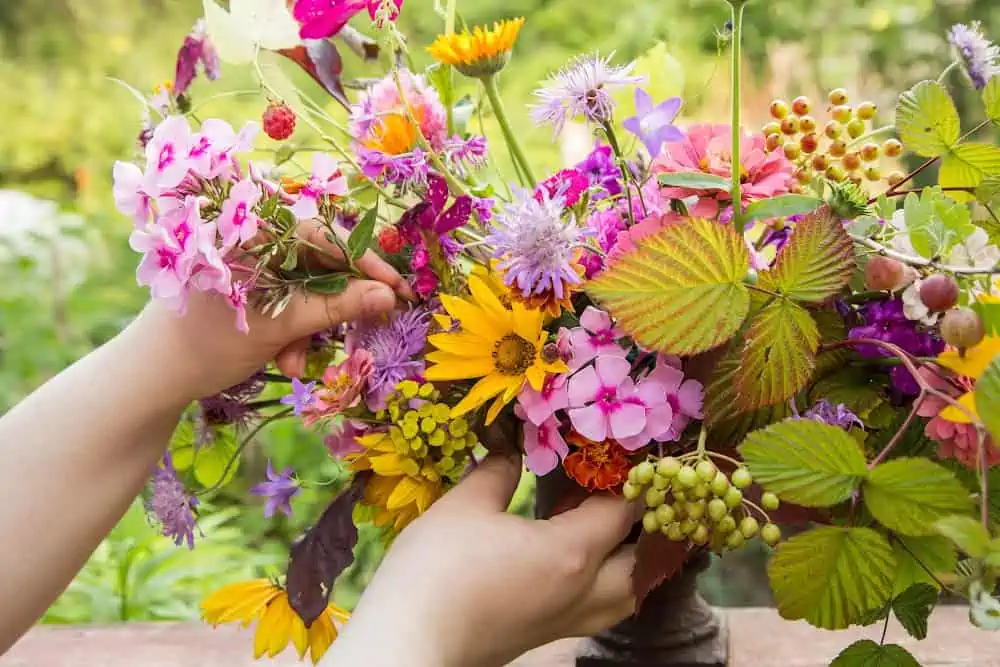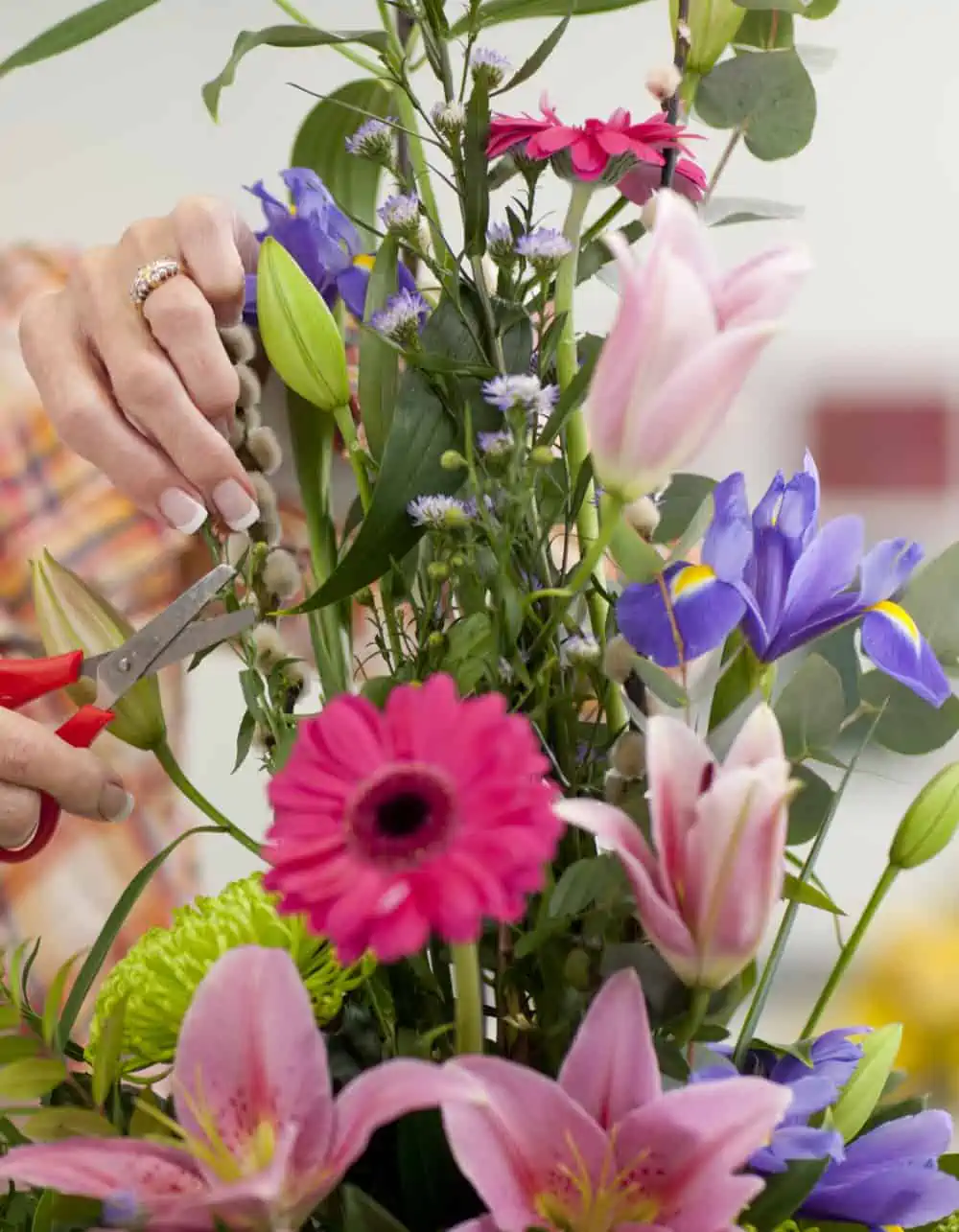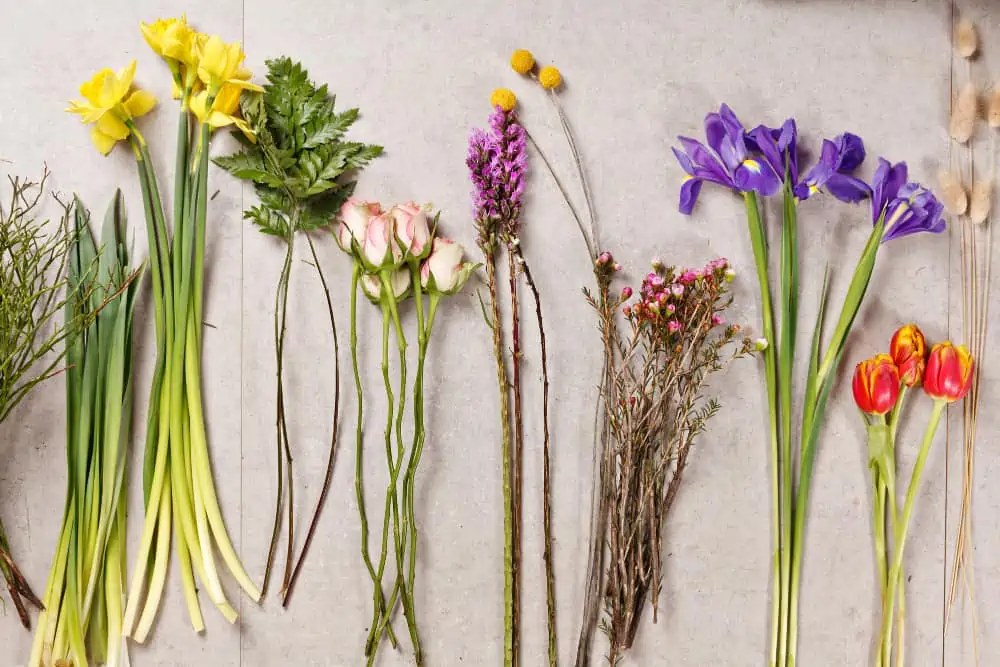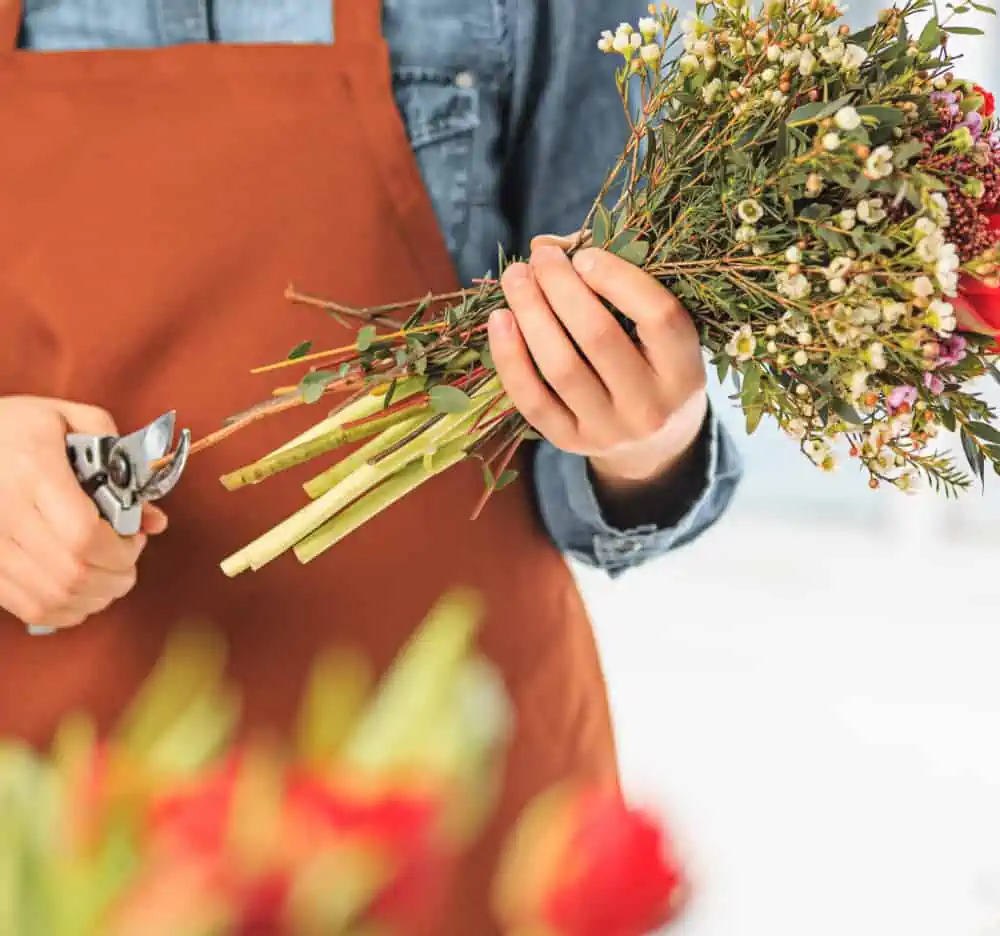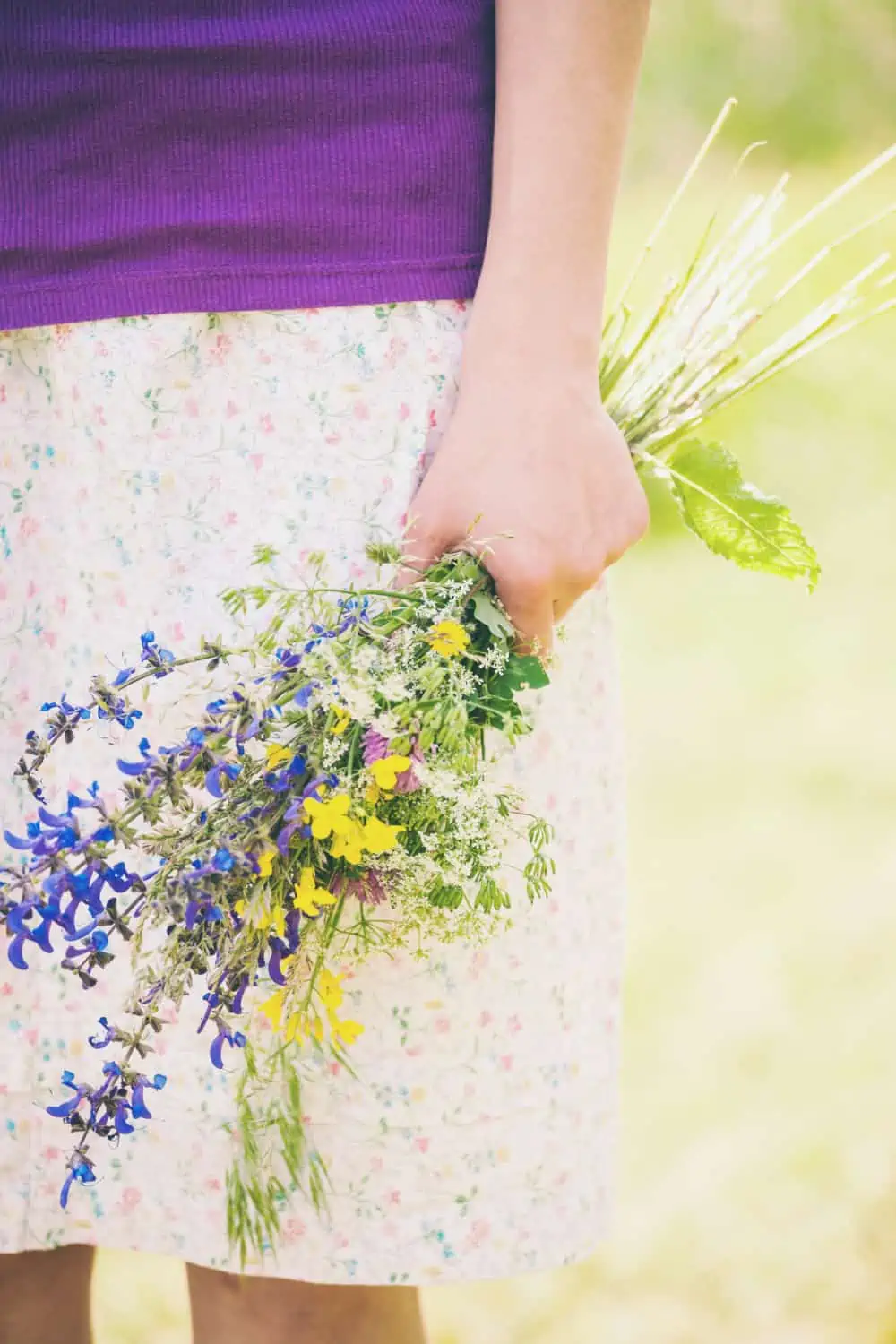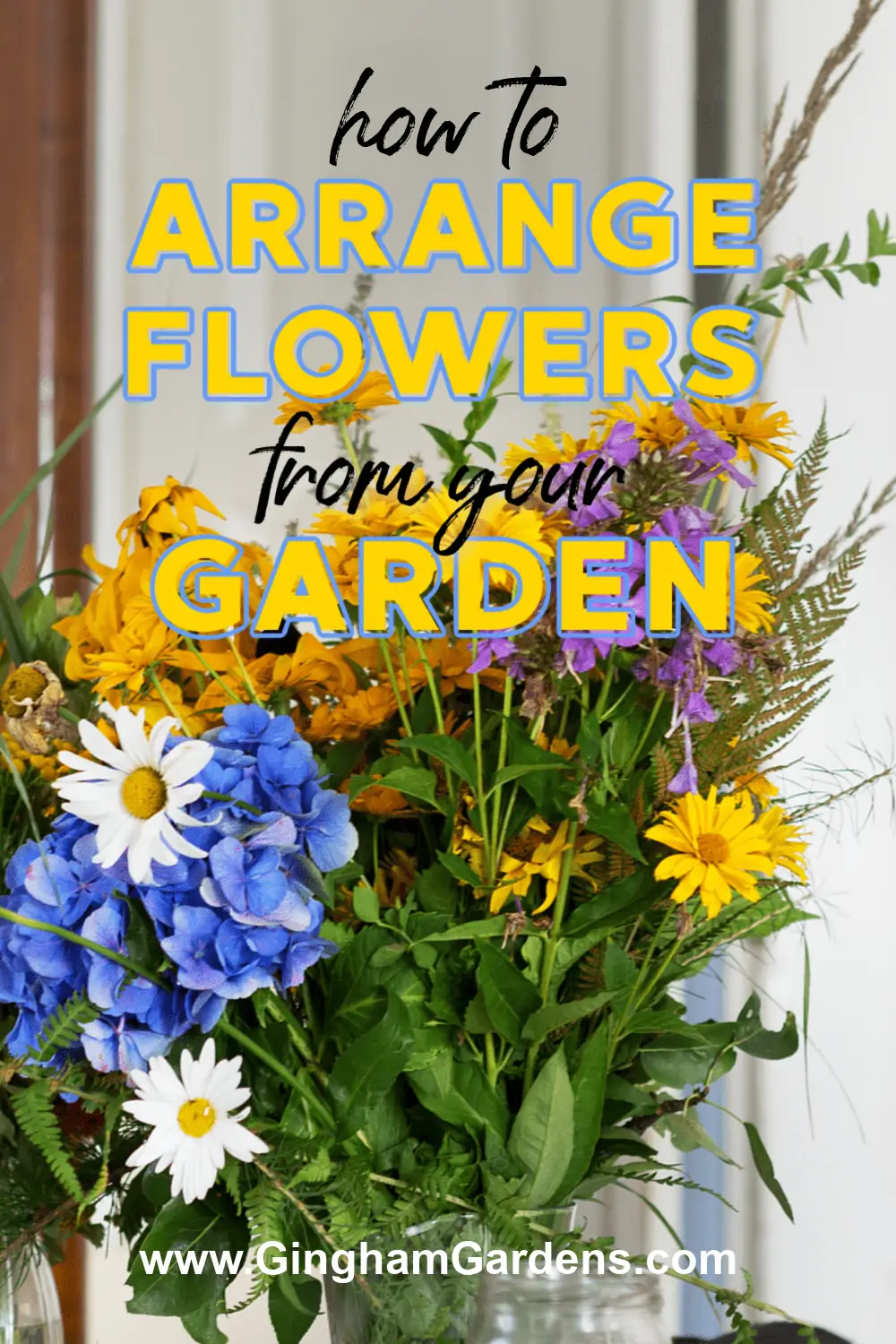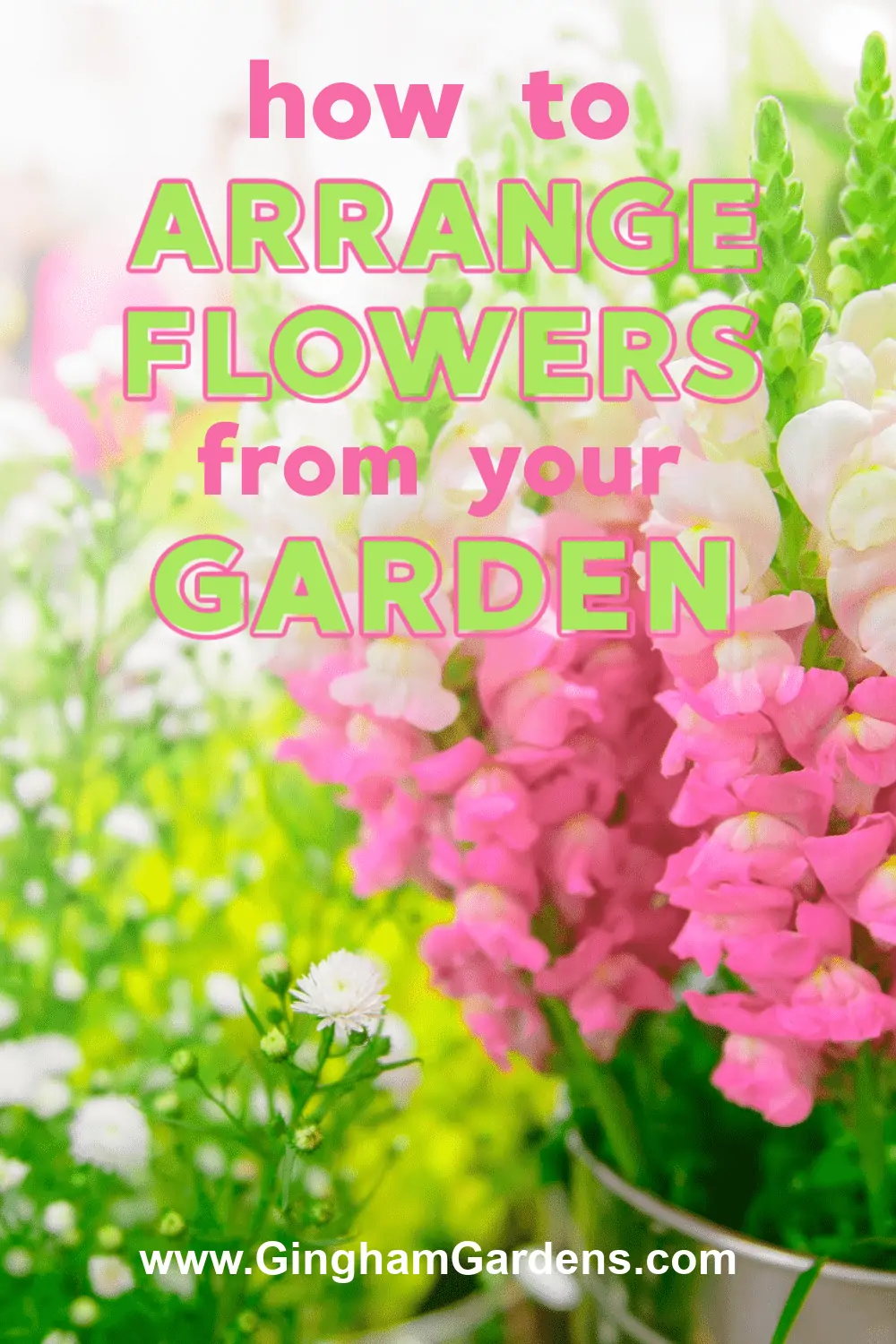How to Arrange Flowers from Your Garden
A fresh bouquet immediately transforms any room. A dreary kitchen becomes light and bright; a stuffy living room feels soft and inviting. Enjoy fresh bouquets anytime when you learn to arrange flowers from your garden! Although it can be lovely to bring in a handful of black-eyed susans or sunflowers, this post is about assembling bouquets of cut flowers from your garden.
Many beginners feel intimidated even thinking about making their own floral arrangements! They feel like they don’t have a large enough variety of flowers to create a beautiful bouquet or tell themselves they don’t have a “good eye.” Flower arranging is easy if you follow a few simple steps. I’ll also share some tips to help you fill in any gaps!
This post contains affiliate links. If you click on
one of the links and make a purchase,
I may receive a small commission at no additional cost to you.
See full disclosure here.
Planning a cutting garden
If you feel drawn to flower arranging, you should learn how to grow a cutting garden for next year! If you have an area that gets full sun, you can grow beautiful flowers for cutting in your own backyard.
Find the best flowers for your growing season and choose types that will fit your favorite color scheme. If there are other flower farmers in your area, watch them to see which varieties grow well and have the same bloom times.
8 Tips for a Gorgeous Homegrown Flower Arrangement
The best way to learn how to arrange flowers from your garden is to practice! You’ll learn more about your style and refine your skills over time. To jumpstart your success, follow these top tips.
1. Grow a variety of different flowers
It takes 3-5 different flower varieties to make a beautiful arrangement. If you work with fewer varieties than this, your arrangement won’t have a lot of visual interest.
That’s not the end of the world, of course, as you may also have other plants growing in your yard or neighborhood that can round out your floral arrangement.
For example, you can raid your herb garden or even forage for fresh foliage to complete your floral centerpiece.
2. Learn when and how to harvest your flowers
This is one of the most important things to learn about flower arranging!
If you harvest too early – Your flowers won’t fully open or will open as the other flowers begin to fade.
If you harvest too late – You’ll notice pollen falling all over your counters and tables, and the blooms will wilt quickly.
Aim to harvest your flowers when they have opened 1/3 of the way. Avoid harvesting flowers starting to produce pollen (look for the powdery pollen in the middle of the flower).
Take a bucket of water with you to your flower bed and while you’re waiting to assemble your bouquet, keep your stems in cool water out of direct sunlight. That way they won’t start to wilt before you get them made into a bouquet.
Harvest any stems by cutting at a 45-degree angle. Be sure to remove the bottom leaves of any flowers, as those can cause your bouquet to go bad earlier.
3. Choose a color palette
For the best floral arrangements, choose the right color scheme for your room and style. There is truly an art to choosing the right color palette. Here are some tips:
- Select 2-3 flowers with similar colors.
- Choose an accent color that picks up a shade or detail or the primary color scheme.
- Add foliage that complements the other colors.
It’s much easier to have plenty of flowers that fit your color scheme when you plan your cut flower garden ahead of time.
Try continually growing neutral flowers and foliage to add texture to your floral arrangements! Baby’s breath, eucalyptus, sweet annie, ornamental grasses, and amaranth are great mainstays you can add to various flower arrangements.
4. Think about flower shape
If you’re intimidated by flower arranging, you probably don’t know about the five types of flowers. This concept is a game-changer! It makes floral arranging so much easier.
What are the five types of flowers?
- Focal flowers – Think big showy blooms like sunflowers, dahlias, roses, chrysanthemums, zinnias, and more.
- Disk flowers – These smaller flowers have a flat, disk-shaped surface and are great for adding a pop of color to your bouquets. Some examples include daisies and asters.
- Spike or line flowers – Add vertical height with delphinium, stock, snapdragons, or bells of Ireland.
- Filler flowers – These delicate flowers fill in the gaps and add volume to your arrangements. Try adding thistle, baby’s breath, lisianthus, spray roses, statice, chamomile, and celosia.
- Foliage – Earthy green botanicals can change the tone of your bouquet from upbeat and lighthearted to wispy and romantic. Have fun with this! Add dusty miller, eucalyptus, salal, cedar, ornamental grasses, and more.
If you have these five types of flowers (or at least 3), you’ll have all the flowers you need for gorgeous bouquets.
The exception to this is bouquets with one type of flower. There are lots and lots of flowers that can hold their own in a flower arrangement and look amazing. A few examples of these are daisies, sweet peas, sweet smelling lily-of-the-valley, colorful zinnias, roses, peonies, and this list can go on and on.
5. Pick a container for your DIY Flower Arrangements
Now, I’m a mason jar girl myself! This is your chance to get creative, so feel free to choose whichever unique vases or containers you have. Here are some fun ideas for displaying flowers from your own cut flower garden:
- Mason jars (all sizes!)
- Small galvanized watering cans
- Old coffee tins
- Vintage crocks
- Thrifted containers
- Repurposed vases
- Check out this selection of unique vases on Etsy.
Take a stroll through your local thrift store to see what you can find. Make sure your container can hold water and your plants can stand up straight without leaning. Otherwise, have fun with it!
6. Grab a floral frog or chicken wire
Although not all flower farmers or florists use a flower frog, they are a great trick to make beautiful bouquets every time.
A floral frog is a device with small holes that hold flower stems in place and fits in the mouth of the vase. This keeps those delicate disk flowers and filler flowers from falling over and keeping those heavier focal flowers in position. An alternative to using a floral frog or chicken wire is to hold the stems together with a rubber band.
They can be made of glass, metal, clay, or other materials. I love this style for mason jar bouquets. You can even use a small circle of chicken wire! A professional florist may use green floral foam, and you can too, but the other options are easier to find and reuse.
7. Start arranging flowers from your garden
Try laying out your fresh flowers on a flat surface to get a sense of your options. This will help you see which flowers go well together and which taller stems need to be trimmed down.
Gather your container and optional flower frog or wire.
Position large flowers prominently. Always add odd numbers of flowers (usually 3 or 5), as this is more visually appealing.
Then, add foliage along the outside of your vase. This will help create a structure for the other flowers, and it’s much easier to add your greens and leaves early on!
Carefully layer in the other flowers at different heights. Add a few disk flowers and spike flowers. These will make draw the eye around the bouquet.
Once you complete your basic structure, go back in and add some filler flowers to complete your arrangement. At first, it might take you a couple of tries to get the shape of the arrangement just right.
Sometimes, I find that it’s easier to arrange flowers in my hand, clip the ends even and then add them to the vase. Go ahead and play around to see what works best for you.
8. No Rules Flower Arranging
Say, you’re a free spirit and you just want to go rogue when making your fresh flower bouquet. That tends to more my style and I can come up with some of the prettiest bouquets when I throw all the rules out the window. I like to take my bucket of water and clippers to the gardens and just start clipping. Go ahead, be creative and try it!
How to Help A Bouquet Last Longer
- To extend the life of your arrangement, add cool water to your vase. The flowers will initially soak up the water, so be sure to add fresh water when needed.
- To prevent the growth of bacteria (that is when the water starts looking gross and murky) replace the water every day or two. I have found that this flower food helps to keep the flowers fresh for a longer period of time.
- Another tip to extend the vase life of your flowers, is to clip off the bottoms of the stems at an angle every time you change the water.
- If some of the flowers start to wilt and look bad, go ahead and pull those flowers out of the arrangement. You might even want to transfer the bouquet to a smaller vase.
Frequently Asked Questions – How to Arrange Flowers From Your Garden
How do you make a bouquet of garden flowers?
Choose 3-5 different types of flowers and plants you’d like to use. Select a container and then begin arranging.
Start by positioning your focal flowers prominently in the center. Then, add your foliage around the edges of your container. Finally, layer in the disk, spike, and filler flowers to complete the arrangement.
How far in advance should you make a bouquet?
The great thing about making bouquets with homegrown flowers is that they are incredibly fresh and should last longer than grocery store flowers from overseas. See the tips above for helping your bouquet last longer. If you are making a bouquet for a special occasion, assemble the bouquet by the day before the event.
Selling fresh flowers from your garden is just one of the ways you can make extra money from your garden.
Whether you’re trying to grow homegrown wedding flowers or just want to brighten up your own home, I hope this post helped you understand how to arrange flowers from your garden with ease! Don’t forget about your friends and family members that don’t grow flowers. I’m sure they would appreciate a vase of fresh cut flowers every now and then. I’d absolutely love to hear about your amazing homemade bouquets, so please share your experience in the comments below!
Happy gardening,
Joanna
Sign up to receive our weekly newsletters full of gardening tips. You’ll also get access to our Gardening Resources Library and all our helpful gardening printables.
More places to find Gingham Gardens:
- Visit Gingham Gardens on Pinterest.
- If you’re on Facebook, Gingham Gardens is also on Facebook.
- Stop by Gingham Gardens’ Amazon store!
- Love Etsy? Come see us on Etsy too.
Pins to Save to Your Favorite Gardening Board:

